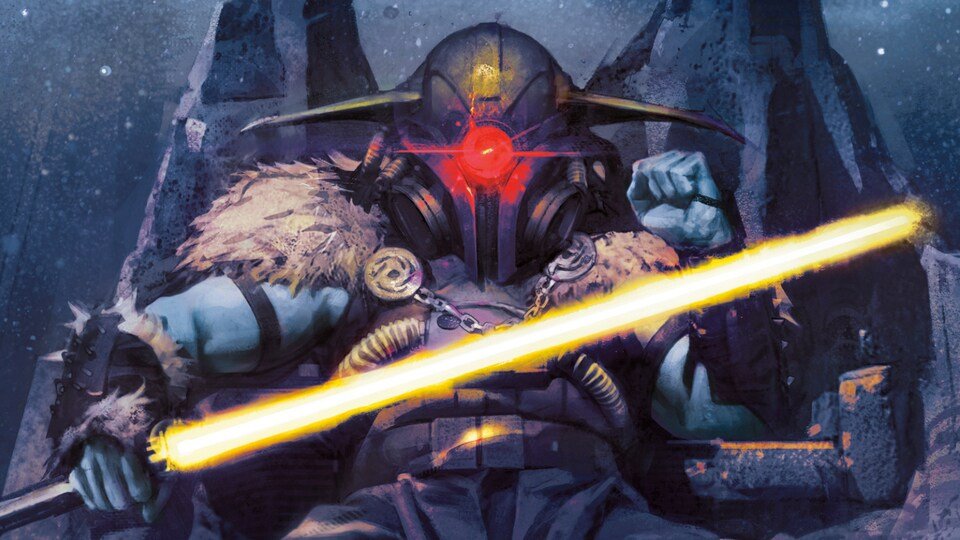Hoth Off The Press: Five Great Star Wars Stories From 2023
A new Hoth Off The Press is available for your reading pleasure! Check out a preview below,
5) The Mandalorian “Chapter 19: The Convert”
A subplot that’s been slowly building throughout The Mandalorian and its spin-offs is the relative effectiveness, or lack thereof, of the New Republic. Early in the first season, we began to hear what the people in the Outer Rim thought of the new government (not much), before beginning to see their attempts to enforce order (with very limited effectiveness) in late season one, season two, and in The Book of Boba Fett.
In season three, we finally head back to the heart of the galactic government and see the New Republic up close for ourselves. What we found is a lot of well-meaning people trying their best to answer an impossible question: what do you do with the enemy population after a war is won?
Sure, you can put heads of state and the worst war criminals on trial so their villainy is exposed to all. But what about the rank-and-file soldiers? Or the general population? The people who weren’t true believers per se, but still worked within the enemy government or war machine.
Enter Dr. Penn Pershing, a scientist who specializes in cloning. His research was valued by the Empire but it wasn’t imperial by definition. He didn’t believe in the Empire so much as need it to fund his research. Now that the Empire has fallen and he is no longer under the influence of Moff Gideon, he entered the New Republic amnesty program for ex-Imperials and is working to re-enter society as a productive citizen.
The amnesty program represents both the best impulses of the New Republic and its limitations. Rather than round up ex-Imperials and imprisoning them (or worse) they are offering them a chance at redemption. Second chances and redemption are central themes in Star Wars and it’s good to see the New Republic led (largely off-screen) by the heroes of the original trilogy attempting to live up to those.
However, it’s a one-size-fits-all solution to a problem with many shapes, sizes, and variations. And when that happens, someone is inevitably going to slip through the cracks.
Enter Elia Kane, one of the amnesty program’s great success stories. Or so it seems. Kane, on the surface, appears to be everything good about the program: the former right-hand woman to Moff Gideon, one of the Empire’s great monsters, who has seen the error of her ways and is now helping other ex-Imperials see the light.
Of course, she’s actually still working for Moff Gideon to advance his evil plans. But no one knows that.
By pairing up Pershing and Kane for some (admittedly convoluted) misadventures, “The Convert” explores the shortcomings of the New Republic. It wants to give reformed Imperials a chance, but it goes about it in a way that leaves them susceptible to influence by those who would draw them back into their old lives.
(The dehumanizing practice of calling them by their numbers rather than their name is straight out of the First Order’s playbook. An understated—but still present—theme of the sequel trilogy is ex-Stormtroopers reclaiming their humanity in the face of a fascistic regime by taking on names instead of numbers. FN-2187 becomes Finn, TZ-1719 becomes Jannah, etc. So it was shocking to see the New Republic engaging in this practice).
While it is never made overtly clear whether Kane is looking to re-recruit Pershing or simply take him off the board as she winds up doing, she succeeds in exposing the weaknesses in the New Republic. A combination of hubris and impersonal bureaucracy (weekly check-ins for amnesty program members are done with droids, for instance) has left their enemies an opening. And one they’re exploiting.
These shortcomings are further explored in Ahsoka, where the hubris of certain high-ranking officials is on full display. But while Star Wars usually shows us these big-picture failings, The Mandalorian offered us a one-episode foray into how these decisions impact those on the ground.
4) The High Republic: The Eye of Darkness
The High Republic publishing initiative follows the classic Star Wars trilogy release chronology. Originals, then prequels, then sequels.
The Eye of Darkness, the new novel by George Mann, kicks off Phase III. It’s a direct sequel to Phase I, while incorporating elements from Phase II which took place chronologically before the events of Phase I. Very Star Wars-y.
Which is a long way of saying, the pressure was on for this novel. Readers spent much of 2021 and early 2022 falling in love with the characters of Phase I, only for (most of) them to be absent from Phase II which was released from 2022-2023. As such, this novel was our first real return to the main story of The High Republic.
The Eye of Darkness works quickly to reestablish the galaxy following the devastation wrought by the end of Phase I. We’re reintroduced to the main players. Marchion Ro, the Eye of the Nihil, now controls great swaths of the galaxy. Supreme Chancellor Lina Soh, the JFK-esque leader meant to bring the Republic into a new age of prosperity. Newly knighted Jedi Bell Zettifar and Burryaga. And the legendary, but grieving Jedi Avar Kriss and Elzar Mann.
It’s Elzar who steals the show in The Eye of Darkness. Grappling with the loss of one friend and the disappearance of another, Elzar decides it is time to step up and fill the void left by his two compatriots. We watch as he deals with imposter syndrome and survivor’s guilt, more acute versions of the general feelings of inadequacy he’s had his entire life. Mann builds up Elzar as a sympathetic character, one we want to see succeed. So when the big twists come, we feel them most directly for how they impact him.
The novel also does an excellent job of balancing a fairly expansive cast across multiple locations. Where the Phase I novels would often be centered around one location (like The Republic Fair or Starlight Beacon), The Eye of Darkness spreads its cast out so we see the effects of the Stormwall (the Nihil’s galaxy diving space-wall) everywhere from the galactic core to the planets trapped beyond it in the Outer Rim.
This allows Mann to explore the novel’s main theme, coming back from loss, in multiple ways. We see how Lina Soh and Elza use the tools of the government to try to fight back, while Avar Kriss and Porter Engle go about helping the people subjugated by the Nihil get by—and fight back—where they can.
All in all, The Eye of Darkness stands as a thrilling beginning to the final act in The High Republic’s story. The wounds from Phase I are still fresh, but they are starting to heal. And with the help of what we learned from Phase II (the lessons of which start to be teased out here), hopefully, the characters we saw fall so hard will bounce back and soar to new heights.


